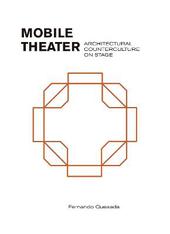
|
Mobile Theater: Architectural Counterculture on Stage
Paperback / softback
Main Details
Description
Taking as a starting point a design for a mobile theater made at the Architectural Association of London between 1970 and1971 by Spanish architect Javier Navarro de Zuvillaga (born 1942), this book traces the architectural counterculture of that time and the relations with the alternative performing arts. Architect Javier Navarro de Zuvillaga (1942) graduated in 1968 at Madrid School of Architecture. During the academic year 1970-1971 he travelled from Madrid to London thanks to a grant of the British Council to complete his postgraduate training at the Architectural Association. There he designed a building called Mobile Theater. It was a theatrical device composed of several 8 x 2,5 meters trucks carefully designed, which contained all the building elements needed to shape a space for the performing arts or other collective uses. The assembly time -estimated for four workers- was six and a half hours. This project was internationally showed and published between 1971 and 1975, but was never built. This book intends to release this project, largely ignored by canonical historiography, and to culturally place it in time and space: the agitated city of London in 1971. After the convulsions of May 1968, architectural counterculture rearmed on very different fronts, from the disciplinary rally to the guerilla positions. This architectural design accounts for these events, since it had a temporal development that goes beyond its mere conception as an artifact. The long and frustrated process for construction -1969 to 1976- calls for a particular intra-history, which this books will tell.
Author Biography
Fernando Quesada is an architect (1995) and PhD. architect (2002), graduated at Madrid School of Architecture (ETSAM). He is professor of architectural design at the School of Architecture of Alcala University (Madrid). Between 1998 and 2000 he was Visiting Scholar (Independent Program) at the Graduate School of Architecture, Planning and Preservation (GSAPP), Columbia University in New York, thanks to a Fulbright grant. Between 2009 and 2010 he was postdoctoral researcher at the Delft School of Design (DSD), TU Delft (The Netherlands). In 2013 he was a guest researcher at Museo Universitario de Arte Contemporaneo (MUAC), Universidad Nacional Autonoma de Mexico (UNAM). Since 2005 he is a member of ARTEA, a research by practice independent association of academics and artists, where he practices research, teaching, production and publication of the performing arts in the expanded field. ARTEA offers a post-professional master's program in the performing arts in collaboration with cultural institutions such as Museum Reina Sofia, La Casa Encendida, or Matadero Madrid. He was co-director of the art and architectural journal O-Monografias, edited by the Galician Association of Architects between 2000 and 2010. He is author of the books La Caja Magica. Cuerpo y Escena (Barcelona 2005), Del cuerpo a la red. Cuatro ensayos sobre la descoporeizacion del espacio (Madrid 2012), and Arquitecturas del devenir (Madrid 2014, Finalist FAD prize). He was editor of Cairon 12. Cuerpo y Arquitectura (Madrid 2009), Comunidad. Comun. Comuna (Madrid 2015), and Ser Publico. Ficciones arquitectonicas para Madrid (Madrid 2017).
|